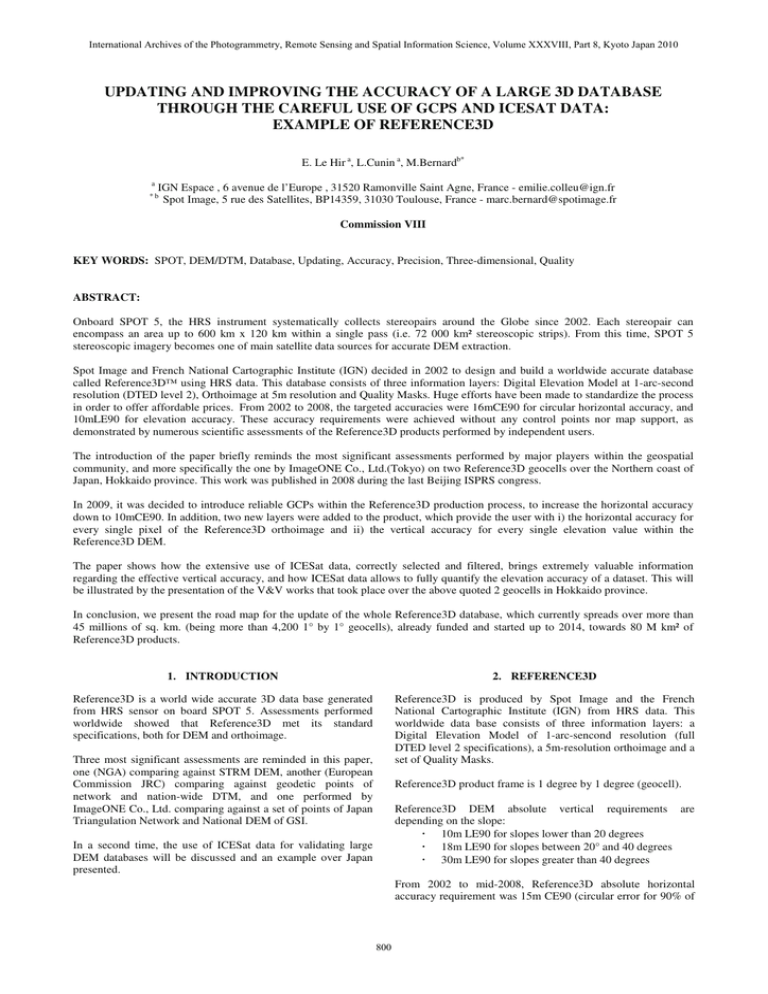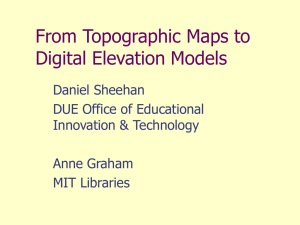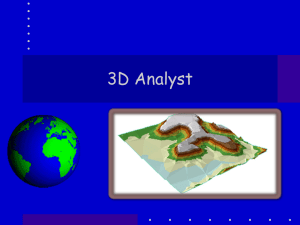UPDATING AND IMPROVING THE ACCURACY OF A LARGE 3D DATABASE
advertisement

International Archives of the Photogrammetry, Remote Sensing and Spatial Information Science, Volume XXXVIII, Part 8, Kyoto Japan 2010 UPDATING AND IMPROVING THE ACCURACY OF A LARGE 3D DATABASE THROUGH THE CAREFUL USE OF GCPS AND ICESAT DATA: EXAMPLE OF REFERENCE3D E. Le Hir a, L.Cunin a, M.Bernardb* a IGN Espace , 6 avenue de l’Europe , 31520 Ramonville Saint Agne, France - emilie.colleu@ign.fr Spot Image, 5 rue des Satellites, BP14359, 31030 Toulouse, France - marc.bernard@spotimage.fr *b Commission VIII KEY WORDS: SPOT, DEM/DTM, Database, Updating, Accuracy, Precision, Three-dimensional, Quality ABSTRACT: Onboard SPOT 5, the HRS instrument systematically collects stereopairs around the Globe since 2002. Each stereopair can encompass an area up to 600 km x 120 km within a single pass (i.e. 72 000 km² stereoscopic strips). From this time, SPOT 5 stereoscopic imagery becomes one of main satellite data sources for accurate DEM extraction. Spot Image and French National Cartographic Institute (IGN) decided in 2002 to design and build a worldwide accurate database called Reference3D™ using HRS data. This database consists of three information layers: Digital Elevation Model at 1-arc-second resolution (DTED level 2), Orthoimage at 5m resolution and Quality Masks. Huge efforts have been made to standardize the process in order to offer affordable prices.From 2002 to 2008, the targeted accuracies were 16mCE90 for circular horizontal accuracy, and 10mLE90 for elevation accuracy. These accuracy requirements were achieved without any control points nor map support, as demonstrated by numerous scientific assessments of the Reference3D products performed by independent users. The introduction of the paper briefly reminds the most significant assessments performed by major players within the geospatial community, and more specifically the one by ImageONE Co., Ltd.(Tokyo) on two Reference3D geocells over the Northern coast of Japan, Hokkaido province. This work was published in 2008 during the last Beijing ISPRS congress. In 2009, it was decided to introduce reliable GCPs within the Reference3D production process, to increase the horizontal accuracy down to 10mCE90. In addition, two new layers were added to the product, which provide the user with i) the horizontal accuracy for every single pixel of the Reference3D orthoimage and ii) the vertical accuracy for every single elevation value within the Reference3D DEM. The paper shows how the extensive use of ICESat data, correctly selected and filtered, brings extremely valuable information regarding the effective vertical accuracy, and how ICESat data allows to fully quantify the elevation accuracy of a dataset. This will be illustrated by the presentation of the V&V works that took place over the above quoted 2 geocells in Hokkaido province. In conclusion, we present the road map for the update of the whole Reference3D database, which currently spreads over more than 45 millions of sq. km. (being more than 4,200 1° by 1° geocells), already funded and started up to 2014, towards 80 M km² of Reference3D products. 1. INTRODUCTION 2. REFERENCE3D Reference3D is a world wide accurate 3D data base generated from HRS sensor on board SPOT 5. Assessments performed worldwide showed that Reference3D met its standard specifications, both for DEM and orthoimage. Reference3D is produced by Spot Image and the French National Cartographic Institute (IGN) from HRS data. This worldwide data base consists of three information layers: a Digital Elevation Model of 1-arc-sencond resolution (full DTED level 2 specifications), a 5m-resolution orthoimage and a set of Quality Masks. Three most significant assessments are reminded in this paper, one (NGA) comparing against STRM DEM, another (European Commission JRC) comparing against geodetic points of network and nation-wide DTM, and one performed by ImageONE Co., Ltd. comparing against a set of points of Japan Triangulation Network and National DEM of GSI. Reference3D product frame is 1 degree by 1 degree (geocell). Reference3D DEM absolute vertical requirements are depending on the slope: 10m LE90 for slopes lower than 20 degrees 18m LE90 for slopes between 20° and 40 degrees 30m LE90 for slopes greater than 40 degrees In a second time, the use of ICESat data for validating large DEM databases will be discussed and an example over Japan presented. From 2002 to mid-2008, Reference3D absolute horizontal accuracy requirement was 15m CE90 (circular error for 90% of 800 International Archives of the Photogrammetry, Remote Sensing and Spatial Information Science, Volume XXXVIII, Part 8, Kyoto Japan 2010 the points). This was achieved without usinng any GCPs or GPS data, as shown by more than 20 assessm ments performed by independent international users (mostly customers), 3 of them reminded here below. In 2009, it was decided to increase the horizontal accuracy better than 10m CE90; this obviously meantt introducing reliable GCPs within the Reference3D production process. To reflect this improvement, two new layers were addded to the product, which provide the user with e single pixel of i) the horizontal accuracy for every the Reference3D orthoimage and ii) the vertical accuracy for every single elevation D DEM. value within the Reference3D Figure 1. Elevation accuracy off Reference3D, displayed by classes of slopes and land uses (from Kay, Winkler, 2004) E3D UNTIL 2008 3. ASSESSMENTS OF REFERENCE 3.3 Assessment by ImageONE (Japan) Until 2008, numerous accuracy assessmentss of the Reference3D products have been performed at inteernational level by independent users. All results showed thaat the Reference3D product met all its specifications. We wouldd like to present three of these assessments. b ImageONE Ltd over two This assessment was conducted by geocells (N43E144 and N43E145) located in Hokkaido Island, in Northern Japan. The N43E144 geocell includes a significant mum elevation 1400m, and ratio of mountains with maxim volcanoes, and lakes. 3.1 Assessments by NGA (USA) 3.3.1 Assessment of the verticall accuracy over Japan Two reference DEM data sets weree used for this assessment: i) a set of 2207 pointts from Japan Triangulation Network maintained by GSI, with cm-level horizontal and vertical accuracies M produced by GSI from the ii) a +/- 50m mesh DTM 1:25,000 topographic maps, m with a vertical accuracy “not better than 5m”. a the Reference3D In 2004, a cross evaluation of the SRTM and DTED level 2 DEMs was simultaneously conducted by NGA and IGN [Bouillon et al., 2006] over twelvve 1° x 1° geocells. This test was followed in 2006 by two otheer tests performed by NGA (concerning 14 geocells). All the results confirmed the full compatibillity of SRTM DTED level 2 DEM (NGA classified) and the Reeference3D products over various landscapes, from very flat dessert areas up to very high mountain areas. m the above listed NGA found that all Reference3D geocells met vertical requirements along slopes. R NGA Regarding the horizontal accuracy of Reference3D, (JACIE tests) evaluated it better than 9m m CE90, through 8 products over the Middle East area (whereaas internal evaluation by IGN over others zones ranged from 5m too 16m CE90). Figure 2. Japan Triangulation Nettwork Points over DEM layer from Reference3D. White rectanngle shows the “Flat Area”. 3.2 Assessment by JRC(Europe) and FÖ ÖMI (Hungary) Figure 1 summarizes another evaluation of o the Reference3D performed by the Joint Research Center Isppra (JRC) and FÖMI [Kay, Winkler, 2004]. One important feaature is the detailed evaluation of the elevation accuracy, througgh segmented classes describing i) the local slope (10°, 20° and 40° thresholds) ii) the land use (agriculture, foreest, urban). Tables 1 and 2 below show the ovverall results of the evaluation against the Triangulation Netw work, which concluded that Reference3D was far better than its specification in this area. Wholee area Flat Area -2..2 -1.7 STDEV (m) 5.33 1.9 Max (m) 11.7 3.3 Min (m) -911.7 -8.3 LE90 (m) 6.77 4.1 Mean (m) ference3D accuracy All of them confirmed that the Refe specifications were met at each slope class. Table 1: Reference3D vs Japaneese Triangulation Network: global results for thhe 2,207 points 801 International Archives of the Photogrammetry, Remote Sensing and Spatial Information Science, Volume XXXVIII, Part 8, Kyoto Japan 2010 Difference intervals -5 / +5m Whole area 2,207 points 85.5% Flat area 367 points 98.4% -10 / +10m 96.6% 100% -15 / +15m 98.3% 100% -20 / +20m 99.0% 100% The statistic of the 120 check poinnts showed a 4m bias (X: 3m ; Y: 2m) and a 12.1m CE90 hoorizontal accuracy (bias not removed). w the frame of the 2008 This evaluation was published within ISPRS Congress in Beijing [Yoshinno et al. ; 2008]. A VERTICAL 4. EVALUATION OF THE ABSOLUTE ACCURACY OF REFERENCE E3D USING ICESAT DATA Table 2: Reference3D compared vs Japaan Triangulation Network: error intervalss From 2009, we began to system matically use ICESat data to qualify the existing Reference3D geocells g to enrich the existing on-the-shelf products with 2 quantified accuracy layers, including a “vertical performance mask”. This layer provides an estimation of the vertical error for each elevation post within the DTED level 2 DEM file (see abovee, section 2). The evaluation against GSI 50m-DTM prodduced similar results. Large differences were noted in an area with w very steep cliffs (caldera lake) with slopes locally higher than t 50°, where the conversion and bilinear resampling of the Reference3D DEM r into Tokyo datum could also have played a role. The computation of the Vertical Performance is based upon a selected to keep only the ICESat data, adequately filtered and most reliable measurements. Table 3 shows the natural degradation of thee results, mainly due to the fact that GSI elevations are bare-soil figures, f 50m posting, moreover coming from the contour lines of o the 1:25,000 scale GSI map series. Difference N43E1444 N43E145 -5 / +5m 73.6% 83.6% -10 / +10m 89.7% 95.6% -15 / +15m 95.2% 98.3% -20 / +20m 97.7% 99.3% 4.1 Use of ICESat data to estimate e local Reference3D vertical accuracy From Carabajal and Harding (22005), the Geoscience Laser Altimeter System (GLAS) on the Ice, I Cloud, and land Elevation Satellite (ICESat) provides a globbally-distributed data set well suited for evaluating the vertical accuracy of digital elevation models (DEMs). These authors quuote horizontal error (2.4 ± 7.3 m) and vertical error (0.04 ± 0.13 m per degree of incidence angle). As compared to the Reeference3D posting size and specifications, these figures are sm mall enough to entitle ICESat a perfect data source to assess Refereence3D local accuracy. Table 3: Reference3D compared againnst GSI DTM. 90% to 95% of the differences are within a 10m range, which is m specification of far better than the 10m / 18m / 30m Reference3D, considering the large mountaiins within N43E144. The first step of the production prrocess is filtering the adequate ICESat dataset (release 28, dataset 14) to carefully select elevations that can be used with noo doubt as “ground truth”. The filtering process is based upon the local slope ; land cover is not considered. 3.3.2 Assessment of the horizontal accuraacy over Japan The horizontal accuracy of the orthoimagee was assessed over N43E144 geocell using 120 Points measureed form the 1:25,000 digital map of GSI, which can be freely acceessed online. From a global number of 1000 too 20000 (on average) ICESat measurements within one Referennce3D 1° x 1° geocell, some 150 to 1000 points are selected (mainly depending upon the relief and the latitude), and the elevation differences against Reference3D DEM are computed. s : The points selection includes two steps - On the area of interest we seeparate by orbit all the data collected, so that we have the alltitudes measured at different dates at the same place within som me 500m maximum distance. - We select flat areas by constrainning the height difference to a given value dh, comparing measurres at a maximum distance dd using data collected on a different day (by constraining the date difference). This is a way to avoiid measurements of cloud, to work only on locally flat areas andd to verify the repeatability of the measures. After this verificattion, one measure is selected and is considered to be valid. 4.2 Generation of the Referencee3D vertical accuracy layer These values are then used to geneerate the Vertical Performance Mask, with the help of the DTE ED 1 SRTM DEM from the Internet. The generalisation processs includes several steps: - Water areas and areas deffined as “possibly outside specification” by the production control process are excluded from the computation of the verticaal accuracy. Figure 3: Check Points (White dots) inn tile N43E144 802 International Archives of the Photogrammetry, Remote Sensing and Spatial Information Science, Volume XXXVIII, Part 8, Kyoto Japan 2010 - The average (AvICESat) and the standard deviation (StdICESat) for all the elevation differences between ICESat and Reference3D are computed on the areas of slope lower than 20 %. The Vertical Accuracy Map value for these areas is given by the formula: 6. DISCUSSION The average alignment of Reference3D and ICESat measurements is impressive, while SRTM shows a slight bias of -1.5m. This could be due to the difference of penetration into the canopy, as the ICESat tracks fly over large areas of sparse or deciduous forest, consistently with [Carabajal and Harding, 2005]. VPM<20 = ¥[AvICESat2 + (1,6 x StdICESat)2] - For the areas of slopes greater than 20 %, we compute the difference between SRTM DEM and Reference3D DEM, and then deduce the average and the standard deviation for all the slope classes (lower than 20%, 20 to 40% and greater than 40 %). The formulas for the VAM values are: Over N43E144, Reference3D really shows less large differences, and far inferior maximum difference with the ICESat “ground truth” than SRTM DEM and GSI DTM. This might come from the vegetation and from its better resolution. VPM20-40 = ¥[Av20-402 + (1,6 x StdICESat x Std20-40/Std<20)2] VPM>40 = ¥[Av>402 + (1,6 x StdICESat x Std>40/Std<20)2] Regarding GSI DTM, being a bare-Earth DEM extracted from maps, the figures can be locally impacted by the sparse forest coverage, though the average does not show any bias versus ICESat. Therefore we computed the difference between GSI and Reference3D elevations, to detect the impact of vegetation. - After the computation, a look-up table is applied on the vertical accuracy map, in order to get a classified visualisation. Thus, the Vertical Accuracy Map expresses the commitment of the producer regarding the accuracy of the delivered elevations. A maximum ratio of 5% of the extent of the geocell can be qualified with an “unknown” accuracy. As shown by Figure 4 below, the influence of different map sheet production lines or field campaigns clearly appears into GSI DTM. Homogeneity is another advantage of Reference3D, as compared to “historical” elevation datasets, frequently handicapped by such phenomena (a similar effect was noted in some regions of France years ago). This computing is done independently for each geocell (which explains the non-seamless look at tile edges) This historical interpretation is confirmed by the inspection of the “Reference3D minus SRTM” DEM, where this effect does not appear. Studies are currently on-going to extend the method to N60°+ (and S58°+) areas, where SRTM is not available. 5. ABSOLUTE VERTICAL ACCURACY OF ELEVATION DATASETS OVER HOKKAIDO (JAPAN) The 2008 evaluation of both N43E144 and N43E145 geocells was revisited during Q1 2010 for this paper, and ICESat data was used to assess the vertical absolute accuracies of several DEMs over these 2 geocells: SRTM DTED 1 DEM, GSI DTM and Reference3D DEM. The results are presented in the Tables below, where figures are in meters and relate to DEM elevation value minus ICESat elevation. (m) Average Std dev. Minimum diff. Maximum diff. Differences > 10m SRTM -1.7 5.0 -27 29 35 REF3D 0.0 3.0 -22 14 6 GSI 0.0 4.8 -29 40 34 Table 4: N43E144. comparison vs 559 ICESat measurements from 4 different tracks (2 ascendant, 2 descendant). (m) Average Std dev. Minimum diff. Maximum diff. SRTM -1.3 1.6 -5 4 REF3D 0.0 1.7 -8 6 Figure 4: GSI DTM / Reference3D difference over N43E144. Blue / red colours show positive / negative differences. Delimitation of map-like frames is clearly visible. The white circles show the locations of the grid-pattern. GSI -0.9 2.1 -8 9 Furthermore, on the central East border of the geocell, a bizarre oblique grid pattern can be observed (Figure 4, white circle). A same pattern shows up in the Northern part of the geocell. The “lines” are 8 to 10m elevation difference along 200m-wide straight lines. Both places are similarly affected within the“Reference3D minus SRTM” DEM. Table 5 : N43E145, comparison vs 270 ICESat measurements from 3 different tracks (1 ascendant, 2 descendant). N43E145 is very flat and 75% covered by sea. 803 International Archives of the Photogrammetry, Remote Sensing and Spatial Information Science, Volume XXXVIII, Part 8, Kyoto Japan 2010 We suspected several mathematical flaws within the t field through the Reference3D process, and finally went to the Reference3D orthoimage and… confirmed with w Google Earth ! M datasets, such as SRTM or history of global elevation DEM Reference3D. d sets provides NASA and Indeed, the apparition of ICESat data other public US players another toool to evaluate and refine the SRTM DEMs and make them moore robust and reliable. Same occurs for Reference3D, when ICE ESat data, available within the public domain, gives IGN and Sppot Image the opportunity of providing the users with an unprrecedented Vertical Accuracy Layer, consisting in an estimationn of the error for each single elevation within the DTED2 Referrence3D DEM. References: H geometric performances: Bouillon et al., 2006, SPOT 5 HRS Using block adjustment as a keyy issue to improve quality of DEM generation, ISPRS Journal of o Photogrammetry & Remote Sensing 60 (2006) 134-136. '!""()*+, -./ !!!"# $#" #"!%&!""(-"! %(0 Kay, Winkler, 2004, Quality cheecking of DEM derived from satellite data (SPOT and SRTM),, 10th Annual Conference on Control with Remote Sensing of Area-based Subsidies. Budapest, 24-27 November 2004. Figure 5 : Wide hedges within the Hokkkaido landscape (as displayed through Google Earth) Regularly spaced hedges are part of the aggricultural landscape of Hokkaido Island. Their width, measured on Google Earth, is approximately 180m. Spacing is variablee from one area to another. The grid pattern of the Referencee3D DEM perfectly matches with the location of the edges, as seeen on Reference3D orthoimage. The travellers’ pictures availabble on Google Earth, confirmed the 8 to 10m order of magnitude of o the trees. Yoshino et al., 2008, Building a consistent geometric frame over Sparse islands using SPOT T 5 data, ISPRS Congress, Beijing, August 2008, Commissionn VII, WG VII/7. Thus, these forest strips, perfectly portrayed within Reference3D, are neither described by thee SRTM DEM, nor (not surprising) by the GSI DTM. While this is OK for use linked with water drainage or soil erosion, itt can severely hinder the uses of these SRTM and GSI elevatioon datasets when it comes to applications such as flying objects or orthorectification of images for agricultural monitoring, automatic change detection, parcel surface measurement, …etcc… Acknowledgements The authors would like to acknow wledge T.Yoshino , H.Muraki , and Y.Yin from ImageONE Ltd (T Tokyo), which work is recalled in section 3.3. 7. CONCLUSION Over the Hokkaido region, Japan, the compaarison of two 1° x 1° Reference3D geocells against ICESat data shows s not more than 6 elevation differences larger than 10m, frrom a total of more than 800 measurements. This is fully compatible with the 6.7m LE90 absolute accuracy measured in 20088 against the highly accurate Japanese Triangulation Network. Over this area, the cross comparison off different elevation datasets such as SRTM, GSI and Referencee3D also allowed to enlighten the lack of homogeneity of GSI G elevation data, probably due to “historical” reasons linkedd with different map production process or field campaigns. Andd also to pinpoint the extreme homogeneity and consistency of large l global datasets such as SRTM or Reference3D (now covvering more than 45 millions of sq.km). Incidentally, it was discovered that Referennce3D was the only dataset to portray the regular grid-shapeed forest strips that rhythm Hokkaido’s agricultural landscapee, thus enabling its users to correctly orthorectify any imagee without undesired distortion. Finally, the availability of ICESat data, witth a perfectly known and mastered accuracy, stands as an importtant milestone in the 804




